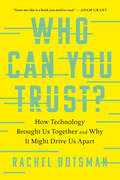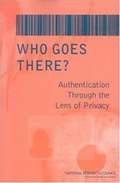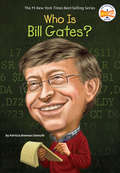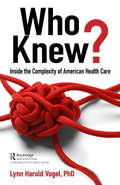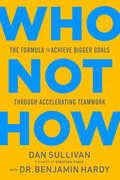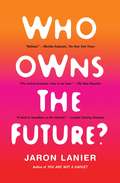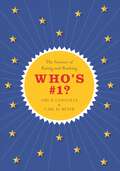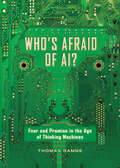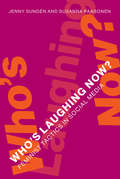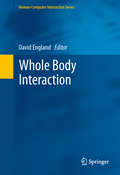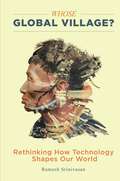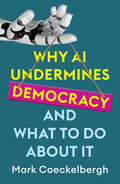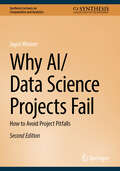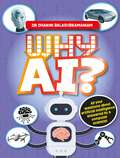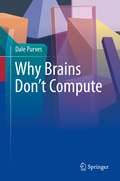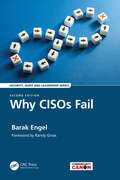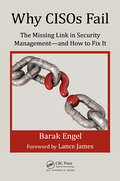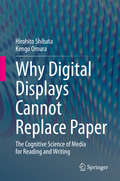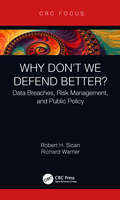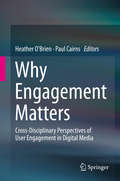- Table View
- List View
White Space is Not Your Enemy
by Kim Golombisky Rebecca HagenDesigning a brochure or web site without an art background? Step away from the computer and read this breezy introduction to visual communications first. Written for non-designers, White Space is Not Your Enemy is a practical graphic design and layout text introducing the concepts and practices necessary for producing effective visual communications across a variety of formats, from print to Web.This beautifully illustrated, full-color book covers the basics to help you develop your eye and produce attractive work. Topics include:* The basics of effective design that communicates its intended message* Pre-design planning* 13 Layout Sins to avoid* Basic typography* Working with color* Storyboarding for video, Web, and presentions* Information graphics* Mini Art School--all the basics in one chapter* Outputting your work
White-Collar Crime Online: Deviance, Organizational Behaviour and Risk
by Petter Gottschalk Christopher HamertonThis initiating monograph provides the first thorough examination of the concept of white-collar crime online. Applying an offender-based perspective which considers the central role of convenience, it seeks to inform, improve and develop the current literature on cybercrime, whilst paying particular attention to its founding category within criminology. It argues that white-collar crime has receded from criminological perspectives on cybercrime in recent years and that a detailed, rich re-assessment of white-collar crime in contemporary digital societies is needed. Following a theoretical introduction, the book develops to discuss, inter alia, implications for corporate reputation, the various organizational roles utilized in mitigating external and internal threats, the unique considerations involved in law enforcement efforts, and likely future directions within the field. White-Collar Crime Online recognises the strong lineage and correlation that exists between the study of white-collar crime and cybercrime. Using convenience theory within a comparative analysis which includes case-studies, the book explores both European and American paradigms, perspectives and models to determine where white-collar crime exists within the contemporary workplace and how this might relate to the ongoing discourse on cybercrime. In doing so it revaluates criminological theory within the context of changing patterns of business, the workplace, social rules, systems of governance, decision making, social ordering and control. White-Collar Crime Online will speak to criminologists, sociologists and professionals; including those interested in cyber-security, economics, technology and computer science.
Who Are You?: Nintendo's Game Boy Advance Platform (Platform Studies)
by Alex CustodioThe Game Boy Advance platform as computational system and cultural artifact, from its 2001 release through hacks, mods, emulations, homebrew afterlives.In 2002, Nintendo of America launched an international marketing campaign for the Game Boy Advance that revolved around the slogan "Who Are You?"--asking potential buyers which Nintendo character, game, or even device they identified with and attempting to sell a new product by exploiting players' nostalgic connections to earlier ones. Today, nearly two decades after its release, and despite the development of newer and more powerful systems, Nintendo's Game Boy Advance lives on, through a community that continues to hack, modify, emulate, make, break, remake, redesign, trade, use, love, and play with the platform. In this book Alex Custodio traces the network of hardware and software afterlives of the Game Boy Advance platform.
Who Can You Trust?: How Technology Brought Us Together and Why It Might Drive Us Apart
by Rachel BotsmanIf you can't trust those in charge, who can you trust?From government to business, banks to media, trust in institutions is at an all-time low. But this isn't the age of distrust--far from it.In this revolutionary book, world-renowned trust expert Rachel Botsman reveals that we are at the tipping point of one of the biggest social transformations in human history--with fundamental consequences for everyone. A new world order is emerging: we might have lost faith in institutions and leaders, but millions of people rent their homes to total strangers, exchange digital currencies, or find themselves trusting a bot. This is the age of "distributed trust," a paradigm shift driven by innovative technologies that are rewriting the rules of an all-too-human relationship.If we are to benefit from this radical shift, we must understand the mechanics of how trust is built, managed, lost, and repaired in the digital age. In the first book to explain this new world, Botsman provides a detailed map of this uncharted landscape--and explores what's next for humanity.
Who Goes There?: Authentication Through the Lens of Privacy
by Committee on Authentication Technologies Their Privacy ImplicationsWho Goes There?: Authentication Through the Lens of Privacy explores authentication technologies (passwords, PKI, biometrics, etc.) and their implications for the privacy of the individuals being authenticated. As authentication becomes ever more ubiquitous, understanding its interplay with privacy is vital. The report examines numerous concepts, including authentication, authorization, identification, privacy, and security. It provides a framework to guide thinking about these issues when deciding whether and how to use authentication in a particular context. The book explains how privacy is affected by system design decisions. It also describes government’s unique role in authentication and what this means for how government can use authentication with minimal invasions of privacy. In addition, Who Goes There? outlines usability and security considerations and provides a primer on privacy law and policy.
Who Is Bill Gates? (Who was?)
by Nancy Harrison Patricia Brennan Demuth Ted HammondBill Gates, born in Seattle, Washington, in 1955, is an American business magnate, investor, philanthropist, and author. In this Who Was...? biography, children will learn of Gates' childhood passion for computer technology, which led him to revolutionize personal computers. Through the success of his now-world-famous software company, Microsoft, Bill Gates became one of the wealthiest philanthropists in history.This fascinating story of a child technology genius is sure to captivate all audiences!
Who Is Tony Hawk? (Who Was?)
by Who HQ Steve KortéLearn about the life and legacy of American skateboard legend Tony Hawk and what makes him one of the most celebrated skateboarders of all time!Tony Hawk, also known as "Birdman," knew from an early age that he was special. Using skateboarding as an outlet for his excess energy, he became a professional skateboarder by age fourteen. He then went on to be named the National Skateboard Association world champion for twelve consecutive years. Among other notable "firsts," Tony Hawk became the first skateboarder to land a "900" trick, earning him the title as the pioneer of modern vertical skateboarding. Although he is known for his skateboarding, he is also an accomplished businessman, philanthropist, and founder of the Skatepark Project, which builds skateparks in underprivileged neighborhoods. Young readers can learn more about the man who ushered in the era of modern skateboarding in this exciting book.
Who Knew?: Inside the Complexity of American Health Care
by Lynn H. VogelDespite all the writing and the research, America’s health care industry continues to fail at providing health care that is accessible and affordable, with measurable quality. The fundamental reason we have failed is that health care is not only a complex business, but the most complex in our economy. Other industries are disrupted, some readily adapt to new markets; some leverage information technology and innovative and cost-saving ways. But to date, health care has resisted. The customary approaches tried in other industries seem not to apply to health care. Why? Why is the health care industry so politically divisive? Why is the quality of health care services so difficult to measure? Why do patients often fail to understand their own health care? Why are security and privacy such unique challenges in health care? Why is the payment process for health care services so complicated and challenging? This book seeks to answer these questions. This book written by a well know industry ‘insider’ with 35+ years working at senior levels in hospital operations and information technology, discusses nine major factors that in combination contribute to health care’s complexity. The author concludes that until we understand why health is so complex, we will continue to see books complaining about the poor state of health care in the U.S., and proposals for change that are generally unsuccessful, and innovative technology products that fail to deliver expected results.
Who Not How: The Formula to Achieve Bigger Goals Through Accelerating Teamwork
by Dan Sullivan Dr. Benjamin HardyThe world's foremost entrepreneurial coach shows you how to make a mindset shift that opens the door to explosive growth and limitless possibility--in your business and your life.Have you ever had a new idea or a goal that excites you... but not enough time to execute it? What about a goal you really want to accomplish...but can't because instead of taking action, you procrastinate? Do you feel like the only way things are going to get done is if you do them? But what if it wasn't that way? What if you had a team of people around you that helped you accomplish your goals (while you helped them accomplish theirs)? When we want something done, we've been trained to ask ourselves: "How can I do this?" Well, there is a better question to ask. One that unlocks a whole new world of ease and accomplishment. Expert coach Dan Sullivan knows the question we should ask instead: "Who can do this for me?"This may seem simple. And it is. But don't let the lack of complexity fool you. By mastering this question, you will quickly learn how billionaires and successful entrepreneurs like Dan build incredible businesses and personal freedom. This book will teach you how to make this essential paradigm-shift so you can: • Build a successful business effectively while not killing yourself • Immediately free-up 1,000+ hours of work that you shouldn't be doing anyway • Bypass the typical scarcity and decline of aging and other societal norms • Increase your vision in all areas of life and build teams of WHOs to support you in that vision • Never be limited in your goals and ambitions again • Expand your abundance of wealth, innovation, relationships, and joy • Build a life where everything you do is your choice--how you spend your time, how much money you make, the quality of your relationships, and the type of work you do Making this shift involves retraining your brain to stop limiting your potential based on what you solely can do and instead focus on the nearly infinite and endless connections between yourself and other people as well as the limitless transformation possible through those connections.
Who Owns the Future?
by Jaron LanierJaron Lanier is the father of virtual reality and one of the world's most brilliant thinkers. Who Owns the Future? is his visionary reckoning with the most urgent economic and social trend of our age: the poisonous concentration of money and power in our digital networks. Lanier has predicted how technology will transform our humanity for decades, and his insight has never been more urgently needed. He shows how Siren Servers, which exploit big data and the free sharing of information, led our economy into recession, imperiled personal privacy, and hollowed out the middle class. The networks that define our world--including social media, financial institutions, and intelligence agencies--now threaten to destroy it. But there is an alternative. In this provocative, poetic, and deeply humane book, Lanier charts a path toward a brighter future: an information economy that rewards ordinary people for what they do and share on the web. grow. It is time for ordinary people to be rewarded for what they do and share on the web. Insightful, original, and provocative, Who Owns the Future? is necessary reading for everyone who lives a part of their lives online.
Who's #1?: The Science of Rating and Ranking
by Amy N. Langville Carl D. MeyerThe mathematics behind today's most widely used rating and ranking methodsA website's ranking on Google can spell the difference between success and failure for a new business. NCAA football ratings determine which schools get to play for the big money in postseason bowl games. Product ratings influence everything from the clothes we wear to the movies we select on Netflix. Ratings and rankings are everywhere, but how exactly do they work? Who's #1? offers an engaging and accessible account of how scientific rating and ranking methods are created and applied to a variety of uses.Amy Langville and Carl Meyer provide the first comprehensive overview of the mathematical algorithms and methods used to rate and rank sports teams, political candidates, products, Web pages, and more. In a series of interesting asides, Langville and Meyer provide fascinating insights into the ingenious contributions of many of the field's pioneers. They survey and compare the different methods employed today, showing why their strengths and weaknesses depend on the underlying goal, and explaining why and when a given method should be considered. Langville and Meyer also describe what can and can't be expected from the most widely used systems.The science of rating and ranking touches virtually every facet of our lives, and now you don't need to be an expert to understand how it really works. Who's #1? is the definitive introduction to the subject. It features easy-to-understand examples and interesting trivia and historical facts, and much of the required mathematics is included.
Who's Afraid of AI?: Fear And Promise In The Age Of Thinking Machines
by Thomas RamgeA penetrating guide to artificial intelligence: what it is, what it does, and how it will change our lives At a breathtaking pace, artificial intelligence is getting better and faster at making complex decisions. AI can already identify malignant tumors on CT scans, give legal advice, out-bluff the best poker players in the world, and, with ever-increasing skill, drive our cars. In Who’s Afraid of AI?, award-winning author Thomas Ramge expertly explains how machines are learning to learn, and he questions what today’s explosion of AI capability could mean for tomorrow: Is it ethical to allow robots—endlessly patient—to replace human caregivers in providing comfort and companionship to the elderly? Since AI feeds on big data, can we prevent its misuse by corporations or the government? Will AI ever be capable of runaway self-improvement? And if “the singularity” does arrive, with AI’s intelligence exponentially outpacing our own, what will become of us when, in many ways, we’re obsolete?
Who's Laughing Now?: Feminist Tactics in Social Media
by Susanna Paasonen Jenny SundenExploring feminist social media tactics that use humor and laughter as a form of resistance to misogyny, rewiring feelings of shame into shamelessness.Online sexism, hate, and harassment aim to silence women through shaming and fear. In Who's Laughing Now? Jenny Sundén and Susanna Paasonen examine a somewhat counterintuitive form of resistance: humor. Sundén and Paasonen argue that feminist social media tactics that use humor, laughter, and a sense of the absurd to answer name-calling, offensive language, and unsolicited dick pics can reroute and rewire shame into a self-assured shamelessness.
Whole Body Interaction
by David EnglandWhole Body Interaction is "The integrated capture and processing of human signals from physical, physiological, cognitive and emotional sources to generate feedback to those sources for interaction in a digital environment" (England 2009). Whole Body Interaction looks at the challenges of Whole Body Interaction from the perspectives of design, engineering and research methods. How do we take physical motion, cognition, physiology, emotion and social context to push boundaries of Human Computer Interaction to involve the complete set of human capabilities? Through the use of various applications the authors attempt to answer this question and set a research agenda for future work. Aimed at students and researchers who are looking for new project ideas or to extend their existing work with new dimensions of interaction.
Whose Global Village?: Rethinking How Technology Shapes Our World
by Ramesh SrinivasanThis critical reassessment of digital proliferation calls for a new approach to technology that includes marginalized, non-western communities. In the digital age, technology has shrunk the physical world into a &“global village,&” where we all seem to be connected as an online community. Yet while we think of platforms such as Twitter and Facebook as open and accessible to all, they are in fact commercial entities developed primarily by and for the Western world. Considering how new technologies increasingly shape labor, economics, and politics, these tools often reinforce the inequalities of globalization, rarely reflecting the perspectives of those at the bottom of the digital divide. This book asks us to re-consider &‘whose global village&’ we are shaping with the digital technology revolution. Sharing stories of collaboration with Native Americans in California and New Mexico, revolutionaries in Egypt, communities in rural India, and others across the world, Ramesh Srinivasan urges us to re-imagine what the Internet, mobile phones, or social media platforms may look like when considered from the perspective of diverse cultures. Collaboration with maginalized communities could pave the way for a people-first approach toward designing and working with new technology worldwide.
Why AI Undermines Democracy and What To Do About It
by Mark CoeckelberghAcross the world, AI is used as a tool for political manipulation and totalitarian repression. Stories about AI are often stories of polarization, discrimination, surveillance, and oppression. Is democracy in danger? And can we do anything about it? In this compelling and balanced book, Mark Coeckelbergh reveals the key risks posed by AI for democracy. He argues that AI, as currently used and developed, undermines fundamental principles on which liberal democracies are founded, such as freedom and equality. How can we make democracy more resilient in the face of AI? And, more positively, what can AI do for democracy? Coeckelbergh advocates not only for more democratic technologies, but also for new political institutions and a renewal of education to ensure that AI promotes, rather than hinders, the common good for the twenty-first century. Why AI Undermines Democracy and What to Do About It is illuminating reading for anyone who is concerned about the fate of democracy.
Why AI/Data Science Projects Fail: How to Avoid Project Pitfalls (Synthesis Lectures on Computation and Analytics)
by Joyce WeinerThis Second Edition addresses five common pitfalls that prevent projects from reaching deployment and provides tools and methods to avoid these pitfalls. Current statistics show that 87% of AI and Big Data projects fail by never reaching deployment, making this book an essential resource for data science and AI practitioners, as well as managers. The author illustrates the methods and tools by including real examples from her experience building and deploying data science and AI projects. This new edition builds upon the original book with revisions, updates and features a new chapter on Generative AI.
Why AI?: All your questions about artificial intelligence answered by a computer scientist
by Dr Dharini BalasubramaniamAll your questions and worries about Al today - the who, what, where, when and WHY - answered by a computer scientist.It's here and it's not going away - AI is on everyone's mind, but many of us don't know what it is never mind what to think about it! Why AI? is a question-and-answer based exploration of the topic for ages 8 and up, from Dr Dharini Balasubramaniam, a computer scientist at University of St Andrews and a passionate advocate for ethics and education in her field. Dr Balasubramaniam's clear and balanced explanations put our mind at ease, while challenging readers to consider how far AI can and should go in certain areas. She introduces us to the history of the concept of machine learning, the pioneers in the field of AI and the amazing AI doing good in the world today. The book includes case studies on fascinating topics, such as search-engine AI and exciting robotics, and answers questions, such as: What did AI start?; Why do we need AI?; What can AI DO?; What should AI do?; What is the future of AI?
Why Brains Don't Compute
by Dale PurvesThis book examines what seems to be the basic challenge in neuroscience today: understanding how experience generated by the human brain is related to the physical world we live in. The 25 short chapters present the argument and evidence that brains address this problem on a wholly trial and error basis. The goal is to encourage neuroscientists, computer scientists, philosophers, and other interested readers to consider this concept of neural function and its implications, not least of which is the conclusion that brains don’t “compute.”
Why CISOs Fail: The Missing Link In Security Management--and How To Fix It (Security, Audit and Leadership Series)
by Barak EngelReleased in 2017, the first edition of Why CISOs Fail reimagined the role of the Chief Information Security Officer in a new and powerful way. Written to be easily consumable by both security pros as well as everyone who must deal with them, the book explores the different realms in which security leaders fail to deliver meaningful impact to their organizations, and why this happens. Its central thesis—that security is primarily a human behavioral discipline rather than a technology one—has been gaining increased attention as a core tenet of the field, and the book was ultimately inducted into the cybersecurity canon as a leading book on security management.In this freshly updated edition, Barak Engel adds new sections that correspond with the chapters of the original book: security as a discipline; as a business enabler; in sales; in legal; in compliance; in technology; and as an executive function. He explores new ideas in each operational area, providing essential insights into emerging aspects of the discipline. He then proposes two critical concepts for security management—the concept of "digital shrinkage" and the transition from CISO to CI/SO—that together offer a new paradigm for any organization that wants to become truly successful in its security journey.Why CISOs (Still) Fail is delivered in Barak's conversational, humoristic style, that has attracted a global audience to this and his other book, The Security Hippie. As he notes, the book's goal is to entertain as much as to inform, and he dearly hopes that you have fun reading it.
Why CISOs Fail: The Missing Link in Security Management--and How to Fix It (Internal Audit and IT Audit)
by Barak EngelThis book serves as an introduction into the world of security and provides insight into why and how current security management practices fail, resulting in overall dissatisfaction by practitioners and lack of success in the corporate environment. The author examines the reasons and suggests how to fix them. The resulting improvement is highly beneficial to any corporation that chooses to pursue this approach or strategy and from a bottom-line and business operations perspective, not just in technical operations. This book transforms the understanding of the role of the CISO, the selection process for a CISO, and the financial impact that security plays in any organization.
Why Data Science Projects Fail: The Harsh Realities of Implementing AI and Analytics, without the Hype (Chapman & Hall/CRC Data Science Series)
by Douglas Gray Evan ShellshearThe field of artificial intelligence, data science, and analytics is crippling itself. Exaggerated promises of unrealistic technologies, simplifications of complex projects, and marketing hype are leading to an erosion of trust in one of our most critical approaches to making decisions: data driven.This book aims to fix this by countering the AI hype with a dose of realism. Written by two experts in the field, the authors firmly believe in the power of mathematics, computing, and analytics, but if false expectations are set and practitioners and leaders don’t fully understand everything that really goes into data science projects, then a stunning 80% (or more) of analytics projects will continue to fail, costing enterprises and society hundreds of billions of dollars, and leading to non-experts abandoning one of the most important data-driven decision-making capabilities altogether.For the first time, business leaders, practitioners, students, and interested laypeople will learn what really makes a data science project successful. By illustrating with many personal stories, the authors reveal the harsh realities of implementing AI and analytics.
Why Digital Displays Cannot Replace Paper: The Cognitive Science of Media for Reading and Writing
by Hirohito Shibata Kengo OmuraFrom readability to operability, this book presents a number of experiments to analyze the characteristics of paper and digital displays in reading and writing. Why is it easy to read on paper? Why is it easy to concentrate on reading on paper? Why is it easy to think while writing or drawing on paper? This book answers these questions based on cognitive experiments on media. Paper is easy to read because it is easy to handle. If we emphasize the strengths of paper, paper is an operation media rather than a presentation media. These experiments also indicate how to develop digital media for reading and writing.This book will interest those who want to gain a scientific understanding of reading and writing on paper, those who want to work more effectively by selectively using paper and digital tools (e.g. knowledge workers and educators), and those who develop digital devices or services for reading and writing.
Why Don't We Defend Better?: Data Breaches, Risk Management, and Public Policy
by Richard Warner Robert H. SloanThe wave of data breaches raises two pressing questions: Why don’t we defend our networks better? And, what practical incentives can we create to improve our defenses? Why Don't We Defend Better?: Data Breaches, Risk Management, and Public Policy answers those questions. It distinguishes three technical sources of data breaches corresponding to three types of vulnerabilities: software, human, and network. It discusses two risk management goals: business and consumer. The authors propose mandatory anonymous reporting of information as an essential step toward better defense, as well as a general reporting requirement. They also provide a systematic overview of data breach defense, combining technological and public policy considerations. Features Explains why data breach defense is currently often ineffective Shows how to respond to the increasing frequency of data breaches Combines the issues of technology, business and risk management, and legal liability Discusses the different issues faced by large versus small and medium-sized businesses (SMBs) Provides a practical framework in which public policy issues about data breaches can be effectively addressed
Why Engagement Matters
by Heather O'Brien Paul CairnsUser Engagement (UE) is a complex concept to investigate. The purpose of this book is not to constrain UE to one perspective, but to offer a well-rounded appreciation for UE across various domains and disciplines. The text begins with two foundational chapters that describe theoretical and methodological approaches to user engagement; the remaining contributions examine UE from different disciplinary perspectives and across a range of computer-mediated environments, including social and communications media, online search, eLearning, games, and eHealth. The book concludes by bringing together the cross-disciplinary perspectives presented in each chapter and proposing an agenda for future research in this area. The book will appeal to established and emerging academic and industry researchers looking to pursue research and its challenges. This includes scholars at all levels with an interest in user engagement with digital media, from students to experienced researchers, and professionals in the fields of computer science, web technology, information science, museum studies, learning and health sciences, human-computer interaction, information architecture and design, and creative arts.



